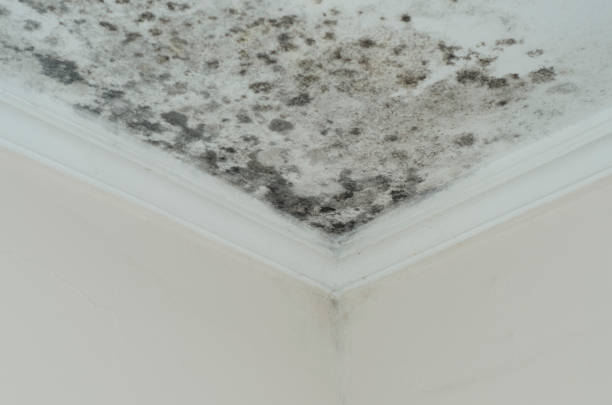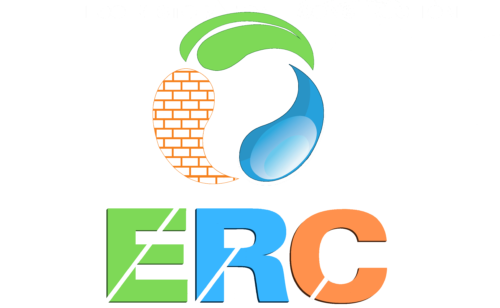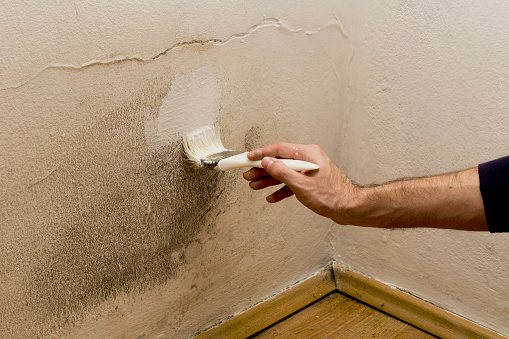Mold should not be painted over. Painting over a mold growth can exacerbate it rather than just covering up an underlying problem. The mold will spread out of sight and even get so big that expert treatment is necessary. Before you can start painting a surface with mold growing, you must first cure the mold growth itself.
What is mold?
Mold is a fungus made up of small creatures that can be found anywhere. However, it has also been reported to manifest as white, orange, green, or purple patches. It typically manifests as black, gray, or brown spots.
Mold grows quickly and thrives on moisture, producing easily inhaled spores and can lead to various health concerns, including breathing difficulties, headaches, fatigue, and nausea.
Covering the dark patches that are the source of the mold, whether with paint or by tearing it up, won’t solve the issue. Mold-resistant paint that stops growth but doesn’t eradicate it right away if it does. No matter how much you paint over mold, if it comes back, trouble will always result.
The most common types of household mold

Although there are dozens of different types of mold, Stachybotrys chartarum, also referred to as “dangerous mold” or “black mold,” is the one most people worry about. This mold species is relatively uncommon, but it’s one of many that produce significant amounts of mycotoxins that can lead to dangerous conditions in the house.
Any mold can pose a health danger if allowed to spread out of control. Therefore, any mold growth discovered by a reliable mold test must be treated immediately to be safe. You would need to contact a specialist to remove the mold.
The more typical mold species that can be found in a home are listed below:
- Mucormycetes: The summer and fall are the best times to look for micromycetes fungi in the soil, such as Cunninghamella Bertholletia, Rhyzomucor species, and Syncephalastrum species. Although it can be challenging to avoid them, most people are usually unaffected by them.
- Alternaria: Alternaria alternata is a mold that causes allergies and is common in the environment. It can enter a home from the outside. Once inside, it can swiftly spread throughout the house; it must be removed immediately with a cleaning containing bleach.
- Aspergillus: Although it is most common in the air, this fungus can also be found in soil, compost piles, grains that have been stored, and dead plants. It can grow and spread across surfaces like clothing, leather, or building material if taken inside a house, especially in moist places.
What happens if you paint over mold?
Although initially covering up mold growths with paint could seem like a smart idea, this is not a prudent move. Many individuals might believe the paint serves as a containment mechanism, trapping the mold and its spores beneath the paint. That is not the situation.
Since mold is a living creature, it will keep expanding beneath the layers of the paint’s surface.
Therefore, no matter how much paint you apply on top of mold growth, the mold will continue to develop since painting over it neither kills the mold nor prevents it from accessing its moist food source.
How to treat mold on walls before painting

If a surface in your house has to be painted, but you’ve observed mold growing, you’ll need to go through the entire mold removal procedure. However, you can get rid of the mold growth using a few simple household chemicals and cleaning tools if it is smaller than 3 feet by 3 feet in size.
As the method for removing mold development varies slightly based on the sort of surface you’re attempting to clean, be sure you’ve chosen the right chemicals and tools for your particular needs.
It would help if you took care of any underlying dampness or moisture concerns that may have contributed to the initial growth of the mold before starting any mold removal procedures. Then, you can start removing the mold after you have dealt with the mold’s cause.
Once the mold has been effectively removed and the area has had a chance to dry thoroughly, you may start making the standard painting preparations and paint the mold-free surface.
Removing mold from bathrooms and other tilted areas
Bathrooms and laundry rooms, in particular, can be vulnerable to mold growth due to their continual contact with moisture and water. Take the following actions to get rid of the mold if you see it growing in a tiled section of your home before attempting to paint the tiles:
- Apply a solution from one cup of bleach and one gallon of water (one part bleach to 16 parts water) to the mold-affected areas.
- For at least 15 minutes, let the bleach solution sit on the moldy spots.
- Clean up, and if necessary, take cover.
- Warm water should be used to clean the area, and it should be left dry and well-ventilated.
Removing mold from drywall and wood
Drywall is a typical surface that mold likes to grow on. Although both surface types are prone to developing mold, one or both may require a fresh coat of paint over time. Therefore, you will need to treat mold on drywall or wood in your home slightly differently than in a tiled area.
Here’s how to remedy moldy drywall or wood in your house using the following instructions:
- Any extra surface mold can be removed with a dry brush or cloth.
- Mix one dishwashing detergent with 10 parts bleach and 20 parts water to create the solution.
- Utilizing a sponge or mop, apply the bleach and detergent mixture to the afflicted regions. Avoid soaking the surface.
- Don’t rinse the afflicted area after applying the bleach and detergent solution.
- Instead, keep the area well-ventilated and let the solution air dry.
Use moisture-resistant primer or paint once the mold has been removed, especially in bathrooms. After the mold has been eliminated, use a premium primer that is moisture- or mold-resistant. These primers don’t kill the mold, but they stop it from growing in the future and stop stains from penetrating the surface. After applying the primer, paint the area with two coats of water-repellent semi-gloss or satin paint.
You may book a free estimate with a mold remediation specialist for all of South Florida if you need help with mold cleanup, sanding, or encapsulating a moldy surface.
A highly trained, experienced expert will come to your house, analyze the issue, and advise you on how to proceed. To discover skilled mold remediation specialists near you, click the button below.






